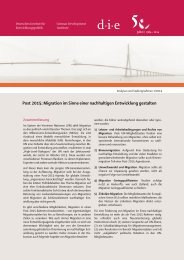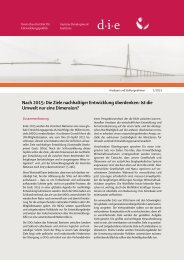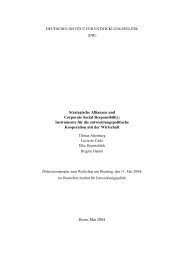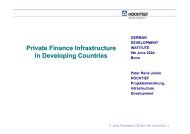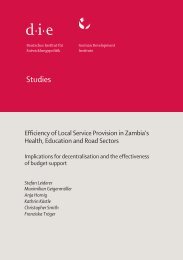Middle East / North Africa and the Millennium Development Goals ...
Middle East / North Africa and the Millennium Development Goals ...
Middle East / North Africa and the Millennium Development Goals ...
Create successful ePaper yourself
Turn your PDF publications into a flip-book with our unique Google optimized e-Paper software.
44<br />
Markus Loewe<br />
The situation is similar for Egypt, Libya, Qatar, <strong>and</strong> Kuwait, each of which<br />
is very likely to reach four, possibly seven, of <strong>the</strong> eight MDGs. All four<br />
countries have <strong>the</strong>ir main deficits in good governance (MDG8).<br />
Major problems in implementing <strong>the</strong> MDGs have been noted for Algeria,<br />
Jordan, <strong>and</strong> Morocco (MDG8, but also MDG1), Bahrain (especially with<br />
respect to MDG2, <strong>and</strong> MDG8), <strong>and</strong> <strong>the</strong> Palestinian Territories (MDG1,<br />
MDG7, <strong>and</strong> MDG8).<br />
Iran, Lebanon, <strong>the</strong> United Arab Emirates (UAE), Saudi Arabia, <strong>and</strong> Oman<br />
are faced with even greater difficulties in reaching most of <strong>the</strong> MDGs by<br />
2015 (see Table A1, Annex).<br />
The prospects of <strong>the</strong> region’s three low-income countries, Yemen, Sudan,<br />
<strong>and</strong> Mauritania, are particularly poor. The way it looks at <strong>the</strong> moment, Iraq<br />
<strong>and</strong> Yemen are likely to miss all eight goals, <strong>and</strong> Mauritania <strong>and</strong> Sudan are<br />
not expected to reach more than one or two of <strong>the</strong> eight MDGs (Mauritania<br />
probably MDG3 <strong>and</strong> conceivably MDG8, Sudan possibly MDG1 <strong>and</strong><br />
MDG3).<br />
These findings will be discussed in more detail in <strong>the</strong> following sections,<br />
which address all eight MDGs in turn. The statistical data cited stem<br />
nearly exclusively from international organizations such as UNDP, <strong>the</strong><br />
World Bank, <strong>the</strong> WHO, <strong>and</strong> UNESCO. Only in a very limited number of<br />
cases use has also been made of <strong>the</strong> data given by <strong>the</strong> national MDG reports.<br />
In very many cases, <strong>the</strong>se data diverge sharply from <strong>the</strong> figures cited<br />
by <strong>the</strong> international organizations. The data presented by <strong>the</strong> World Bank,<br />
UNDP, <strong>and</strong> UNESCO are by no means always in agreement, which goes<br />
above all for <strong>the</strong> indicators used for MDG2, MDG5, <strong>and</strong> MDG7, but <strong>the</strong><br />
international organizations are at least at pains to cite only data that are<br />
based on similar st<strong>and</strong>ards (definitions, classification criteria, <strong>and</strong> survey<br />
methods). In o<strong>the</strong>r words, <strong>the</strong>se data on different countries are more useful<br />
for purposes of comparison. Ano<strong>the</strong>r striking fact here is that <strong>the</strong> data presented<br />
in national MDG reports show, almost invariably, positive deviations<br />
from <strong>the</strong> statistics published by <strong>the</strong> international organizations. This<br />
would seem to indicate that many governments in <strong>the</strong> <strong>Middle</strong> <strong>East</strong> <strong>and</strong><br />
<strong>North</strong> <strong>Africa</strong> have succumbed to <strong>the</strong> temptation to use <strong>the</strong>ir MDG reports<br />
to brighten up <strong>the</strong> situations in <strong>the</strong>ir countries.<br />
German <strong>Development</strong> Institute



